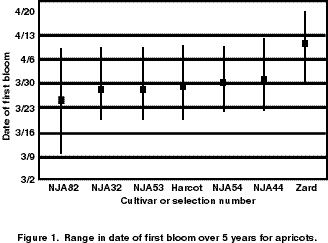
![]() The flavor is slightly tart when firm ripe, becoming mild when soft ripe.
The flavor is slightly tart when firm ripe, becoming mild when soft ripe.![]() Fruit hang well
Fruit hang well
and the firmness is good, making this selection suitable for commercial production.
![]() NJA114 (Jerseycot x NJA93)
NJA114 (Jerseycot x NJA93)
A large apricot ripening with Harcot.![]() This selection tends to bloom later than most of our other
This selection tends to bloom later than most of our other
apricot selections, including Jerseycot.![]() Fruit are round-oblong, slightly compressed, 5.5 to
Fruit are round-oblong, slightly compressed, 5.5 to
6.0 cm (2.2 to 2.4 inches).![]() The fruit are orange with no blush.
The fruit are orange with no blush.![]() The flavor is generally mild but
The flavor is generally mild but
it has been tart in a couple of years.![]() Fruit have good firmness, making this selection suitable for
Fruit have good firmness, making this selection suitable for
commercial production.
![]() NJA82 (I13-36 x NJA11)
NJA82 (I13-36 x NJA11)
A large apricot ripening with Harcot.![]() This selection is one of the earliest blooming apricots in
This selection is one of the earliest blooming apricots in
our collection, yet it often sets at least a light crop, suggesting that it may possess some
tolerance to spring frosts.![]() Fruit are oblong, slightly compressed, 4.5 to 5.5 cm (1.8 to
Fruit are oblong, slightly compressed, 4.5 to 5.5 cm (1.8 to
2.2 inches).![]() The fruit have a 5-40% red blush over an orange ground color with a slightly green
The fruit have a 5-40% red blush over an orange ground color with a slightly green
suture in some years.![]() The fruit are tart when firm ripe, but the flesh becomes very sweet when
The fruit are tart when firm ripe, but the flesh becomes very sweet when
the fruit are soft ripe with soluble solids in the range of 16-21%.
![]() A86-83, A86-86, and A86-105 (Glabrousapricots)
A86-83, A86-86, and A86-105 (Glabrousapricots)
Tom Foley of North American Fruit Explorers (NAFEX) provided us with open pollinated (OP)
seed of an apricot cultivar called John Bonn Small from Door County, WI.![]() He reported that this
He reported that this
strain is cold hardy, self-fertile, and quite inbred.![]() From this OP seed we obtained three glabrous
From this OP seed we obtained three glabrous
apricots that completely lacked pubescence.![]() We have been using these selections in our
We have been using these selections in our
breeding program but at this time we do not know the mode of inheritance of the glabrous
character.
![]() SUMMARY
SUMMARY
The focus of the NJAES tree fruit breeding program has been the development of productive
commercial tree fruit cultivars with superior fruit quality and improved disease resistance.
Because of the renewed interest in growing white-fleshed peaches and other novel stone fruit,
our program has intensified its efforts to develop white peaches and nectarines for shipping,
peen tao or doughnut peaches, and apricots.![]() Several new cultivars are now available and in the
Several new cultivars are now available and in the
next few years the number will be increasing.![]() Tree fruit breeding is a long-term endeavor
Tree fruit breeding is a long-term endeavor
usually requiring at least 15 years between the time when the cross is first made and when the
new variety can be recommended for release.![]() Our program has been aggressively producing the
Our program has been aggressively producing the
next generation of seedlings which will provide improved varieties into the coming century.
The objectives of the breeding program continue to evolve to better satisfy the future needs of
the fruit industry and society.
![]() 1998.
1998.![]() Is there a white peach in your future?
Is there a white peach in your future?![]() Tri-State Horticultural Meeting,
Tri-State Horticultural Meeting,
![]() Jan. 27 – Jan. 29, Hershey, PA.Pennsylvania Fruit News 78:43-45.
Jan. 27 – Jan. 29, Hershey, PA.Pennsylvania Fruit News 78:43-45.
![]() 1995.
1995.![]() Apricot tree NJA53.
Apricot tree NJA53.![]() US Plant Patent No. 9,255.
US Plant Patent No. 9,255.
![]() 1994. Apricot tree NJA54.
1994. Apricot tree NJA54.![]() US Plant Patent No. 8,674.
US Plant Patent No. 8,674.

![]() 1992.
1992.![]() Stony hard gene of peach alter ethylene biosynthesis, respiration, and
Stony hard gene of peach alter ethylene biosynthesis, respiration, and
![]() other ripening-related characteristics.
other ripening-related characteristics.![]() HortScience 27:122.
HortScience 27:122.
![]() Frecon.
Frecon.![]() 1995a.
1995a.![]() NJA53 apricot.
NJA53 apricot.![]() HortScience 30:389-390.
HortScience 30:389-390.
![]() Frecon.
Frecon.![]() 1995b.
1995b.![]() NJ54 apricot.
NJ54 apricot.![]() HortScience 30:385-386.
HortScience 30:385-386.
![]() Cell wall changes in ripening
Cell wall changes in ripening
![]() peach from cultivars differing in softening rate.
peach from cultivars differing in softening rate.![]() Acta Hort. 343:200-203.
Acta Hort. 343:200-203.
![]() Apricots (
Apricots (![]() Prunus
Prunus![]() ).
).![]() p. 63-107.
p. 63-107.![]() In: J.N.
In: J.N.
![]() Moore and J.R. Ballington (eds.), Genetic resources of temperate fruit and nut crops.
Moore and J.R. Ballington (eds.), Genetic resources of temperate fruit and nut crops.
![]() International Soc. for Hort. Sci., Wageningen, Netherlands.
International Soc. for Hort. Sci., Wageningen, Netherlands.
![]() Jerseycot apricot.
Jerseycot apricot.![]() HortScience
HortScience
![]() 22:680-681.
22:680-681.
![]() 1998.
1998.![]() Effect of propylene on ripening of different flesh type
Effect of propylene on ripening of different flesh type
![]() peaches.
peaches.![]() ATTI IV Giornate Scientifiche, Societa Orticola Italiana, April 1-April 3,
ATTI IV Giornate Scientifiche, Societa Orticola Italiana, April 1-April 3,
![]() Sanremo, Italy.
Sanremo, Italy.![]() 4: 621-622.
4: 621-622.
![]() Inbreeding and coancestry of
Inbreeding and coancestry of
![]() freestone peach cultivars of the eastern United States and implications for peach
freestone peach cultivars of the eastern United States and implications for peach
![]() germplasm improvement.
germplasm improvement.![]() JASHS 110:547-552.
JASHS 110:547-552.
